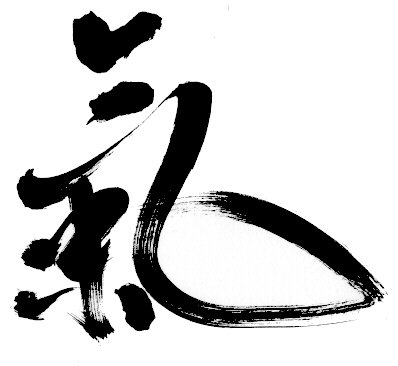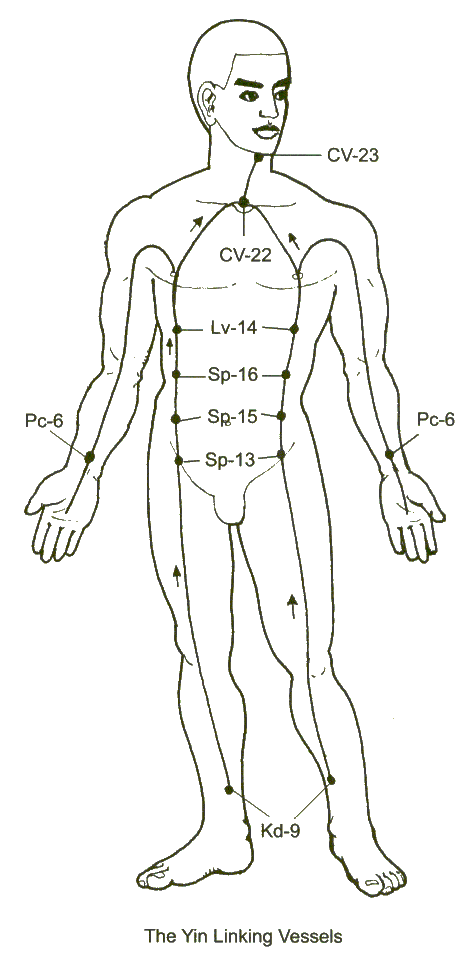[Scientific Qi Exploration 气的科学探讨]
The Extraordinary Meridians or Vessels (Part 3)
Marty Eisen Ph.D.
14. The Yin Heel (Qiao) Vessels (Mai)
Qiao can be translated as “heel” or “to stand on toes.” The Yin and Yang Heel Vessels are also called Bridge Vessels since they act as a bridge to link the body’s stored Qi with areas requiring Qi to ensure a balanced distribution of energy.
The Yin Heel Vessels begin at K 2 (Ran Guo, on the medial side of the foot, distal and inferior to the medial malleolus, in the depression distal and inferior to the navicular tuberosity). It ascends to K 6 and then to K 8 and continues up the medial aspect of the leg to the inguinal region, where it enters the genitals. From the genitals, it travels up the anterior abdomen and the chest to ST 12 (Que Pen, in the midpoint of the supraclavicular fossa, 4 cun lateral to the anterior midline). From ST 12 it travels to ST 9 (Ren Ying, Level with the tip of Adam’s apple where the pulsation of common carotid artery is palpable, on the anterior border of sternocleidomastoid muscle and along the cheek to Bl 1 (Jing Ming, .1 cun medial and superior to the inner canthus of the eye, near the medial border of the orbit), as shown in Figure 7.
At Bl 1 it meets the Bladder, Du and Yang Qiao Mai vessels. From there some sources state that it rises upwards and enters the brain.
15. Functions and Uses of the Yin Heel Vessels
The Yin Heel Vessels control the Yin of both sides of the body. They influence the regions of the body through which they pass (the legs, male and female reproductive systems, lower abdomen in females, head and eyes). They can be used for the following problems,
(a) To treat symptoms of Excess in the Yin Heel Vessel resulting in cramping of some leg muscles on the medial sides, which rotate the legs inward and invert the feet. With this condition if a person is relaxed and lying supine, the legs will turn inward or the feet will invert.
(b) To treat Deficiency in the Yin Heel Vessels causing the feet to turn outward and also insomnia.
(c) To balance the right and left sides of the body’s structure.
(d) To treat the symptoms of Excess in the Lower Burner in women such as abdominal distention, abdominal fibroids, masses and lumps, difficult labor, or the retention of the placenta.
(e) To treat Excess Yin causing painful urination, difficult bowel movements, diarrhea, stomach rumbling, vomiting, hypotension, and unconsciousness.
(f) For eye diseases due to Excess in the Yin Heel Vessels such as heavy sensations of the eyelids or an inability to open the eyes while trying to stay awake, watery eyes, congestive headaches, migraines; sleepiness.
(g) To treat Deficiency of the Yin Heel Vessels that can lead to insomnia, headaches at night, cramps or convulsions, and worsening of symptoms during the evening.
The Heel Vessels are responsible for the formation of the motor nerves during fetal development. According to traditional Chinese medicine, the Yin Heel Vessels are responsible for making little girls less active than little boys (2).
16. The Yang Heel Vessels
It originates at Bl 62 (Shen Mai, in the depression directly below the external malleolus) and travels behind the heel to Bl 61 (Pu Can, 1.5 cun inferior to the center of the depression, midway between the prominence of the lateral malleolus and the posterior border of the Achilles tendon, in a tender depression on the calcaneum). It continues up the calf to Bl 59, up the lateral aspect of the leg to GB 29 (Ju Liao, on the lateral aspect of the hip joint, at the midpoint of a line drawn between the anterior superior iliac spine and the prominence of the greater trochanter). Then, it goes up the back to the scapular region at SI 10. It continues to LI 15 and LI 16 and then travels to the face and connects with ST 4, ST 3, ST 1 and Bl 1 where it meets with the Bladder, Du and Yin Qiao Meridians. From there, it travels over the head and terminates at GB 20. See Figure 8.
17. Functions and Uses of the Yang Heel Vessels
The Yang Heel Vessels control the Yang of both sides of the body and influence the regions through which they pass. They can be used for the following problems.
(a) To treat symptoms of Excess in the Yang Heel Vessel resulting in cramping of some leg muscles on the lateral sides, which rotate the legs outward and evert the feet. With this condition if a person is relaxed and lying supine, the legs will turn outward or the feet will evert.
(b) To treat Deficiency in the Yang Heel Vessels causing the feet to turn inward and sleepiness.
(c) To treat Excess Yang in the Yang Heel Vessels leading to problems such as hypertension, spontaneous sweating, head sweating, paralysis of the arms and legs, swelling of the body, pain in the joints, thigh tumors, and not being able to bend (stiff back and waist).
(d) To treat Excess Yang in the Yang Heel Vessels leading to eye problems such as pain, dry and itchy eyes, difficulty in closing the eyes, and insomnia.
(e) To treat Excess Yang in the Yang Heel Vessels leading to head problems like bad colds, nose bleeding, headaches, and deafness.
(f) To purge Wind Cold or Wind Heat producing symptoms such as headache, sneezing, runny nose or stiff neck.
(g) To treat Internal or External Wind in the head giving rise to dizziness, facial paralysis, aphasia, etc.
(h) To treat acute Excess conditions of the lower back like painful spasms or invasion of Cold and pain along the leg Bladder Meridians.
(i) To treat Deficiency symptoms such as lassitude, weakness and fatigue during the day, which improve as it turns darker.
According to some traditional Chinese medicine texts if epilepsy occurs at night, the Yin Heel Vessels are treated. However, if it occurs during the day, then treat the Yang Heel Vessels. These Vessels are also responsible for making little boys more active than little girls. In the newborn, Excess Yang in the Yang Heel Vessels can cause vomiting of milk.
18. The Yin Linking (Wei) Vessels
Wei means to link. The Linking Vessels act as reservoirs for the Primary Meridians storing overflowing Qi and Blood and releasing Qi and Blood into these Meridians when the flow is insufficient. Hence, they are also called the Regulator Vessels. The Yin Linking Vessels connect with all the main Yin Meridians (Liver, Heart, Spleen, Lung, Kidney and Pericardium).
Figure 9. The Yin Linking Vessels
The Yin Linking Vessels begin at Kd 9 (Zhu Bin) and ascend on the medial sides of the legs, the abdomen and the chest until the center of the male nipples or St 17 (Ru Zhong, in the fourth intercostal space, 4 cun lateral to the anterior midline). At St 17 the Vessels they divide into two sets of branches. One set of branches connects with the Conception Vessel in the neck. The other set becomes Yin Yu (Surplus) Vessels and run from the chest over the shoulders following the Pericardium Meridian to Pc 6 (Nei Guan, 2 cun above the transverse crease of the wrist, between the tendons of m. palmaris longus and m. flexor radialis). From Pc 6 it flows into the palms.
19. Functions and Uses of the Yin Linking Vessels
These Vessels can be used for the following problems.
(a) To treat Blood Deficiency resulting in headaches in the back of the neck.
(b) To treat gastrointestinal problems such as difficulty in swallowing, vomiting, spasms, constipation, indigestion, abdominal swelling, ulcers, diarrhea, hemorrhoids, internal fullness of chest, and prolapsed rectum.
(c) To treat Yin and Blood Deficiency, especially if there are also mental symptoms like anxiety, unrest, and insomnia.
(d) To Tonify the Heart for symptoms such as fullness, pain, or stiffness in the chest, accompanied by nightmares, depression, apprehension, and timidity.
20. The Yang Linking Vessels
They connect with all the Yang Meridians (Large Intestine, Stomach, Small Intestine, Bladder, Triple Heater and Gallbladder) and move the Yang energy. They control the Protective (Wei) Qi’s resistance to External Evils. If the Yang energy is diminished in the Yang Linking Vessels, the Excess Yin can lead to lowered resistance to cold and fever.
They originate at Bl 63 (Jin Men, on the lateral side of the foot, in the depression posterior to the tuberosity of the fifth metatarsal bone and ascend the lateral sides of the legs and back to SI 10 (Nao Shu, when the arm hangs down in adduction, the point is directly above the posterior end of the axillary fold, in the depression inferior to the scapular spine). SI 10 is the point of intersection of the Yang Linking and the Yang Heel Vessel. From the SI 10 points, both Linking Vessels splits into two sets of branches.
One set of branches ascends the sides of the neck and head to GB 20 (Feng Chi, in the depression between the upper portion of m. sternocleidomastoideus and m. trapezius, on the same level as a horizontal line immediately below the external occipital protuberance), where it meets the Governing Vessel.
The other set of branches are Yang Yu Vessels which flow down the back sides of each arm following the trajectory of the Triple Heater (Burner) Meridian to TB 5 (2 cun proximal to the dorsal wrist crease in the depression between the radius and the ulna, on the radial side of the extensor digitorum communis tendons) and then into the back of the hands. See Figure 10.
21. Function and Uses of the Yang Linking Vessels
These Vessels can be used for the following problems.
(a) To treat Excess symptoms like pain in the lateral sides of the head, neck, trunk and legs (along the Gallbladder Meridians), alternating chills and fevers, rashes, night sweats, dizziness especially if they occur during weather changes.
(b) To treat ear diseases caused by Liver Fire rising (tiinitus, deafness, etc,) and also due to Gallbladder problems.
(c) To treat hypochondriac pain.
(d) To treat Deficiency symptoms such as loss of energy and strength, feelings of coldness and lack of body heat, fatigue and stiffness, especially during rainy or cold weather.
References
- Hammer, L. I. The Extraordinary Acupuncture Meridians: Homeostatic Vessels. Am. J. of Acupuncture, Vol. 8, No. 2, June 1980.
- Johnson, J.A. Chinese Medical Qigong Therapy. Int. Institute of Medical Qigong, Pacific Grove, CA, 2000.
- Maciocia, G. The Foundations of Chinese Medicine. Churchill Livingstone, New York, 1989.
- Chen Youbang, et al, eds. Chinese Acupuncture and Moxibustion. Foreign Language Press, Beijing China, 1990.
- Eisen, M. Scientific Qi Exploration. Part 2. The Collaterals. yang-sheng.com, Nov./Dec., 2013.
- Mitchell, D. Heavenly Streams: Meridian Theory in Nei Gong. Singing Dragon, London, 2013.
 Marty Eisen, PhD, is a retired scientist, who constructed mathematical models in medicine. He has studied and taught Yoga, Judo, Shotokan Karate, Aikido, Qigong, Praying Mantis Kung Fu, and Tai Chi. Dr. Eisen studied Chinese Medicine through apprenticeships and correspondence courses. His new Amazon Kindle and hard copy books “Healthy Exercise for Seniors and Non-Athletes” describes classical Yoga, Tai Chi and Qigong to encourage practitioners to learn more about these arts. For more information about Dr. Eisen please visit http://kungfutaichiqigong.com .
Marty Eisen, PhD, is a retired scientist, who constructed mathematical models in medicine. He has studied and taught Yoga, Judo, Shotokan Karate, Aikido, Qigong, Praying Mantis Kung Fu, and Tai Chi. Dr. Eisen studied Chinese Medicine through apprenticeships and correspondence courses. His new Amazon Kindle and hard copy books “Healthy Exercise for Seniors and Non-Athletes” describes classical Yoga, Tai Chi and Qigong to encourage practitioners to learn more about these arts. For more information about Dr. Eisen please visit http://kungfutaichiqigong.com .




One Response to The Extraordinary Meridians or Vessels (3)